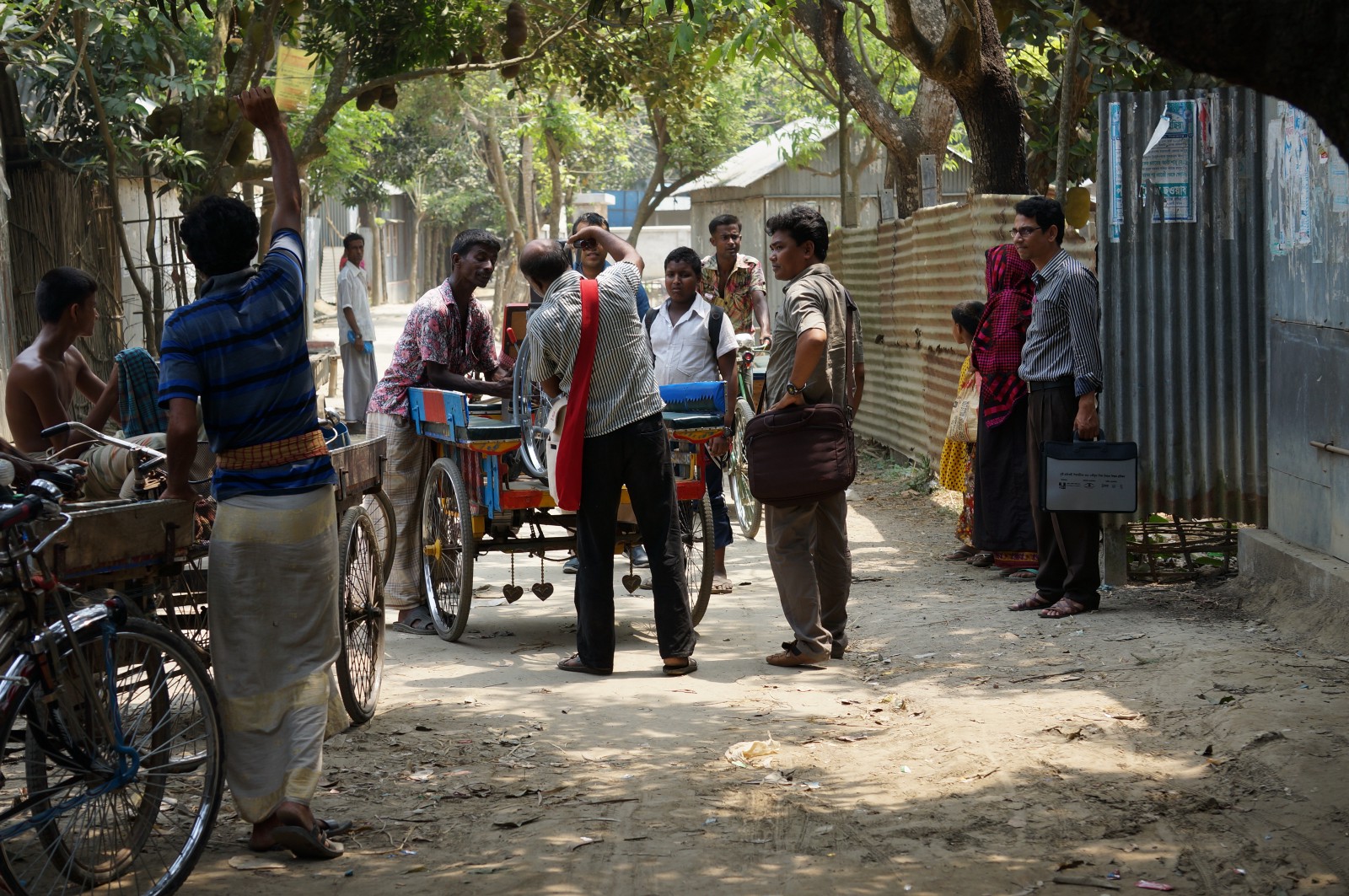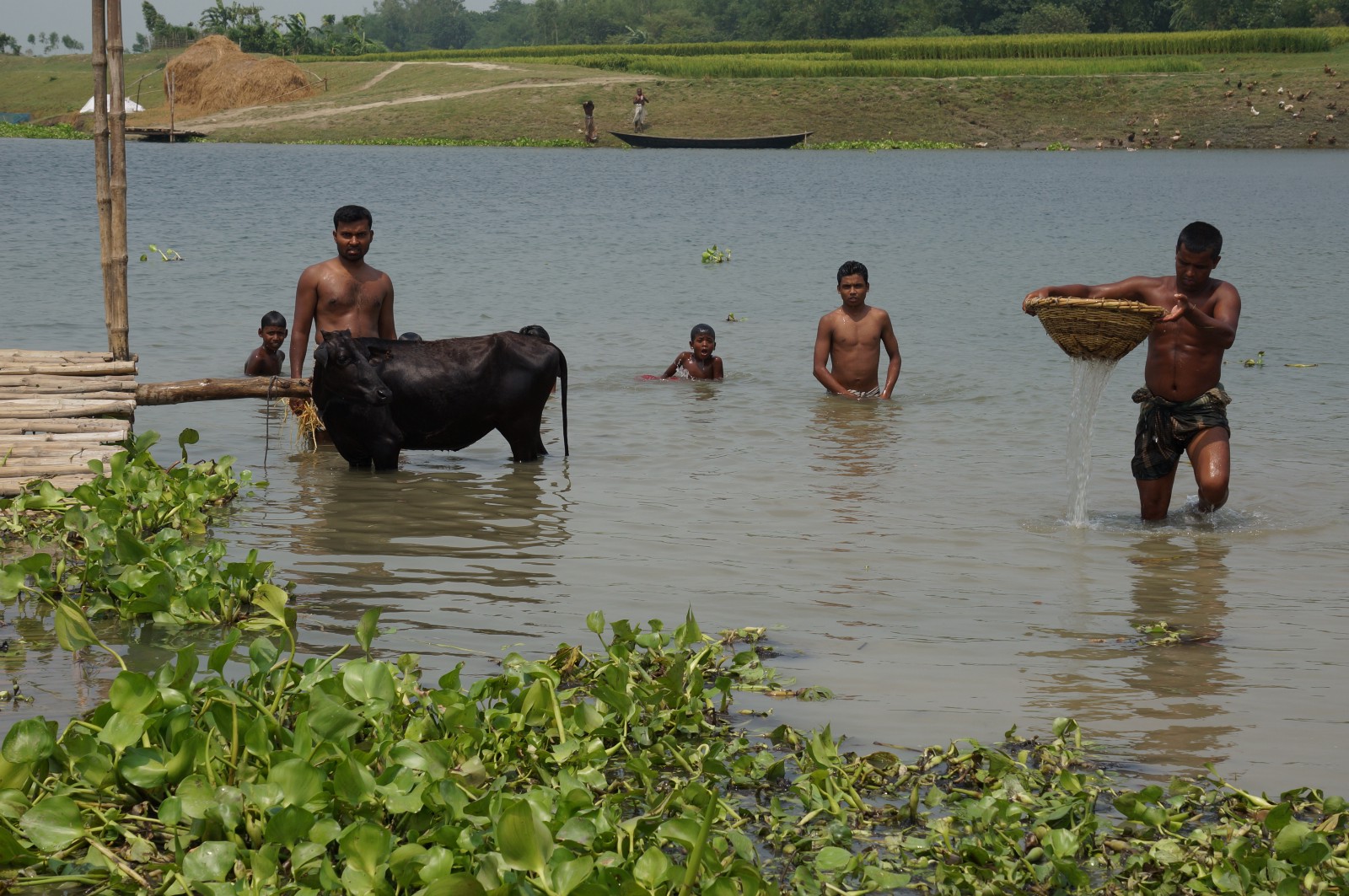Riding with Gulam Khandaker, the doctor working to reform the treatment of cerebral palsy in rural Bangladesh.
By Mark Isaacs
Dr. Gulam Khandaker with Ummey Salma. (Photo: Mark Isaacs)
An overburdened rickshaw, hand-painted in stripes of blue, green, and yellow, bounces along a dirt road past fields of sparkling green rice paddies. The local Bengali villagers stare. Six men and a wheelchair share the motorized rickshaw, a rare sight in these parts. The strange consortium is headed to Char Norina,a small village in the Shahjadpur sub-district. Their mission is to deliver a wheelchair to Ummey Salma, one of the hidden children of Bangladesh.
Among the group is Dr. Gulam Khandaker, a Bengali-born, Sydney-based doctor attempting to witness and record the plight of Bangladeshi children suffering from cerebral palsy.
Gulam insists that we call him Gulam — Dr. Khandaker makes him sound too stuffy, he says — and laments Bangladesh’s lack of dedicated rehabilitative services for children with cerebral palsy, not to mention the country’s poor track record in early diagnosis and data-gathering.
“There is no current accurate data for children with cerebral palsy in Bangladesh,” Gulam says, shifting in his seat with boisterous excitement. “What I am trying to do is create a registry of all these children and their problems. I then refer them to the appropriate level of support they will need.”
Two years ago, Gulam became disillusioned with the effectiveness of his role as a pediatrician in Australia and turned to public health, determined to make a difference on a larger scale. By conservative estimates, over three Bangladeshi children per 1,000 will have some sort of cerebral palsy. In 2014, with support from the Australian Cerebral Palsy Alliance, Gulam teamed up with the Child Sight Foundation to start a pilot project to assist suffering children. Considering the high rate of cerebral palsy among a population of over 161 million, it’s clear Gulam has come to the right place.
“What needs to change are attitudes. Many people in Bangladesh still think seeing a disabled child first thing in the morning is bad luck.”
Gulam brought me to Bangladesh as a friend — we were introduced to each other by my father (his supervisor) but thanks to his enthusiasm and generosity I’ve become engrossed in his project. I now find myself squashed onto a rickshaw in northern Bangladesh with Gulam and the staff from CSF. Gulam has organized an agreement with an Australia-based voluntary organization Wheelchairs for Kids (WFK) to provide 166 wheelchairs to kids with cerebral palsy in the community. WFK is run by retired volunteers in Australia, who make and distribute over 300 wheelchairs each month to poor disabled children in developing countries. Gulam purchased this particular chair for Ummey Salma with his own money. Gulam is coy about how much of his own money he uses to support his program, but I get the impression he is quite generous. He says he can always find another cost that needs to be met (he already meets all his own expenses and once, while I was there, he paid for medicines for the clinic out of his own pocket) but he is worried his wife will get angry at him if he calculates the exact cost.

Members of the Child Sight Foundation load a wheelchair onto a rickshaw. (Photo: Mark Isaacs)
It is harvest time in the sub-district, which means the fields must be tended and many of the families can’t afford to come to Gulam’s clinic. In this case, Gulam visits them. To get to Ummey Salma’s village, we have taken a minivan and are about to begin a boat ride across a river, after which another rickshaw will take us the rest of the way. Gulam sees the journey in reverse, and from the families’ eyes: how difficult it must be with disabled children. When we arrive at Ummey Salma’s house, she is carried out on a plastic chair by two family members gripping a bamboo beam between the chair’s legs. As she thrashes her arms, her face contorts into an involuntary smile; she is level 5 cerebral palsy (based on the Gross Motor Function Classification System), which means she cannot sit, stand, or walk independently, even with adaptive equipment. She is 15 years old and it is a difficult task for the two women to carry her.
I was shocked at just how awful things were for Ummey Salma. I could see that the combination of rural Bengali poverty and a completely dependent disabled child could lead to a worn-out caregiver and an ignored child.
A mother confesses to Gulam that she tried to kill her own child by putting a pillow over the child’s face. A grandmother asks for medicine to reduce her grandson’s libido.
One of Gulam and CSF’s primary goals is to support those caregivers, whose futures so often look bleak and burdensome.
“It is a form of slavery,” Gulam says. “Forced to stay at home, unable to work or do anything other than look after the child, placing more financial burden on the already impoverished family. There is no support, no education. They are in an impossible situation and nobody cares. It’s natural they blame the child.”
A mother confesses to Gulam that she tried to kill her own child by putting a pillow over the child’s face. A grandmother asks for medicine to reduce her grandson’s libido. His sexual habits are difficult to manage in a one-bedroom home, and his parents don’t care for him. A 17-year-old mother is blamed for her child’s condition because she spent part of her pregnancy studying for her high school exams. This same mother is now forced to stay at home and care for her child. Sometimes, disabled children are abandoned by parents who cannot cope financially or emotionally. A child called simply “Mud Boy” was abandoned and now spends his days lying in the mud.

Villagers wash in a river just outside of Char Norina. (Photo: Mark Isaacs)
The wheelchair for Ummey Salma is obviously much needed, and despite Gulam’s claim that it’s “the best $200 [he] ever spent,” the moment is bittersweet.
“Seeing her here in her home, I realize how hard it is for the family,” he said. “She is skinnier than when I last met her, and it looks like she is kept in the stable with the animals during the day so the family can watch her while they work.”
If Ummey Salma had been referred to a physiotherapy clinic from toddler age, like the children to whom CSF now provides assistance, her disability could have been far better managed. This type of scenario is precisely what Gulam and the CSF are fighting against: Together they are trying to establish a rural one-stop service for children with cerebral palsy, where they can provide comprehensive rehabilitative and basic medical care as well as information and services for parents and families, including physiotherapy, speech pathology programs, assistive devices, and epilepsy treatment. Gulam also notes the importance of saving and supplying expensive saliva control medication, an invaluable drug for the seven-year-old girl whose spit otherwise streams out of her mouth and down her chest causing a painful rash. They are also looking to open an adjacent dental clinic.
Gulam is keen to shift any praise he receives to the people who matter, his colleagues at CSF. “I am here sporadically. Simion, Utpal, Brother Moina: they are the ones who care for the children round the year,” he says.
“Two of the richest families I saw had the worst level of care for their children. One child slept naked on the floor, while the other was hidden in a dark corner of a room.”
In a country where one-third of the population lives below the poverty line, it is easy to see how disabled children become invisible to the rest of society. This is especially true in Bangladesh, where disabled children are treated with mistrust by the general public, symptoms of longstanding stigma and superstition. Poverty alone doesn’t explain the frequently inhumane treatment of disabled children in Bangladesh.
“Two of the richest families I saw had the worst level of care for their children,” Gulam says. “One child slept naked on the floor, while the other was hidden in a dark corner of a room. The family told me he preferred the dark. Both came to me with bed sores and one child had scaly skin. What needs to change are attitudes. Many people in Bangladesh still think seeing a disabled child first thing in the morning is bad luck.”
One of the most difficult challenges Gulam must overcome is parents’ unwillingness or inability to adapt their attitudes. All too often he hears: “If they can’t be cured, what’s the point?”
“They are scared. They want to know who will care for their children when they are not around. The reality is that one in 10 children die of cerebral palsy every year in Bangladesh; most of the children I see will die at a young age,” Gulam says.
The mortality rate for children with cerebral palsy is high in Bangladesh, and during my visit Gulam must take one mother aside to explain that her child will not make it another year. Mothers whose children have died still sometimes come to the office to ask for a photograph of their dead children because they don’t have any. Early treatment can make a huge difference in forestalling early death and improving quality of life.
Gulam’s teenage patients are beyond much help. But then a young couple arrives — a 15-year-old mother and a 19-year-old father carrying their 11-month-old infant. Gulam tells me there is hope for this child.
Back in Char Norina, word has spread through the houses that Gulam and the CSF staff have arrived. Families who have previously avoided or could not reach the CSF office start to make their way to the medical staff. Within minutes there are eight new patients, confirming what Gulam already suspected: that the community had been harboring many unregistered, untreated children with cerebral palsy. Gulam’s visit to this village could mean the difference between a child who dies too soon and one with a shot at making it to adulthood and, while these successes motivate Gulam to continue his work, the real drive comes from the thousands of children hidden in villages all over Bangladesh who need his help.

||




